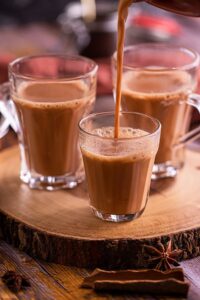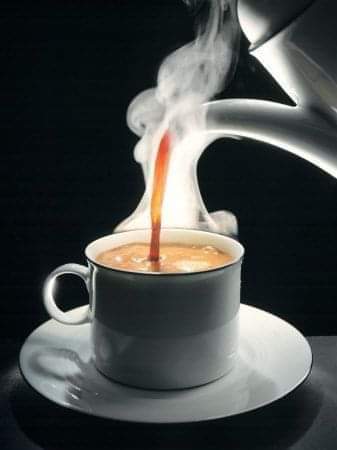Recently, on May 21 was celebrated as ‘International Tea Day’. Chai isn’t just a beverage. It brews on as a symbol of one of the most cherished tenets that we as a civilisation adopted — where we embraced all that the other cultures offered us and added our own flavours.
 There is a four-letter word that has dominated Indian minds and hearts for ages. While Indians are indeed associated with the warmth of love, the word that has spelt both warmth and love for generations of Indians is C-H-A-I.
There is a four-letter word that has dominated Indian minds and hearts for ages. While Indians are indeed associated with the warmth of love, the word that has spelt both warmth and love for generations of Indians is C-H-A-I.
The diverse Indian terrain changes every few kilometres as do languages and dialects. However, most desi mornings, waking up to the rich-in-anticipation sound of pestles crushing generous doses of ginger in kitchen mortars for the morning cuppa is a constant.
The second largest producer of tea in the world is a big consumer of its product, too. In the financial year 2021, India’s consumption of tea stood at a massive 1.1 billion kilograms.
But the glory of the Indian tea, popularly called chai, lies not in quantitative measures but in its qualitative nuances that also change with region and weather. While tea is largely considered as a significant introduction by the British, India’s first brush with this brew is perhaps older. It is believed that the Sanjeevani Booti that brought an unconscious Lakshman back to life in the epic Ramayana was actually tea!
While the British did work on popularising this beverage by establishing tea plantations in Assam, Darjeeling, and the Nilgiris, it was the invention of the cut-tear-curl (CTC) method of making tea which made it more affordable to the Indian masses.
The tea that evolved since then was adapted by each region in its own way with local flavours giving rich aromas to its brew, not to forget the generous dose of sugar or jaggery that brought additional texture and sweetness. Today, even the most popular masala chai changes its proportion of spices as per preference and season. From the flavourful Kashmiri kahwa that has saffron, cinnamon, ginger and other herbs, to Assam’s strong, malty flavoured Lal Chai, to the heavy, cream-laden dense Irani Chai, the consistency of the tea changes, but not the consistent love it gets as India’s favourite beverage.
Up in the hills of Uttarakhand, you can taste katki chai, where you’d bite on a piece of jaggery (size depending on your preference) and sip unsweetened masala tea with it. This iron-rich concoction is considered beneficial for the physical labour-intensive lifestyle of pahadis. The lemongrass-and-mint-laden Parsi chai would keep you refreshed in coastal weather. Even on the hottest day in Rajasthan, you’d find people huddled around tea-stalls serving kulhad chai, with the earthen pot adding its own taste to the concoction. And, while some may like their cups and mugs full, the forever-on-the-move Mumbaikar resorts to cutting chai — half-a-cup but enough to refresh the senses and break the mid-day slumber.
 In our country of big differences, chai is quite a leveller. Whatever you may call these roadside thelas and shops — thadi in Jaipur, tapri in Delhi, lari in Vadodara or amruttulyas (nectar-like) in Pune — there is no denying that tea is our most loyal beverage. There is bed tea you could wake up to, attend fancy events where chai is poured through decorated tea-cozied pots, be snooty about serving only Lopchu tea to guests or have stimulating and intellectual discussions at the chai stall under the office building —you would never run out of the many ways to have your tea.
In our country of big differences, chai is quite a leveller. Whatever you may call these roadside thelas and shops — thadi in Jaipur, tapri in Delhi, lari in Vadodara or amruttulyas (nectar-like) in Pune — there is no denying that tea is our most loyal beverage. There is bed tea you could wake up to, attend fancy events where chai is poured through decorated tea-cozied pots, be snooty about serving only Lopchu tea to guests or have stimulating and intellectual discussions at the chai stall under the office building —you would never run out of the many ways to have your tea.
While we bond over “tea breaks” and “tea time”, there is no one time to have chai. Many of us enjoy a late-night cup of tea, sitting on our own, as our me-time, while some of us don’t see a point in having chai without sharing conversations (and snacks). And, in some families, it is rather offensive for a guest to say no to chai! After all, why say no to a cup full of love?
Our “first flush” with chai is a soft emotion of its own. While growing up, offering “tea” from our “tea sets” to whoever we came across, we had our first real taste through a biscuit, a toast or a nankhatai generously dunked into the tea cup of a family elder before becoming old enough to graduate to a cup of our own, not to mention the times when we dunked the Parle-G biscuit for too long, breaking it before we could have it.
Our first impressions of childhood train rides would also be incomplete without the constant sound of ‘chai-chai’ at every station and in between, too, with hawkers doing multiple rounds of selling the beverage across bogies. And, while we may sip our tea at fancy cafes today, a much-loved chai ritual, still popular among seniors, is balancing the tea on the saucer and slurping it up.
The Indian topography keeps changing every few kilometres, but what is constant is the love for this beverage as a beginning, mid-morning, evening or anytime refreshing cuppa of energy. Chai certainly isn’t just a beverage. It brews on as a symbol of one of the most cherished tenets that we as a civilisation adopted — where we embraced all that the other cultures offered us and added our own flavours. This one is truly an entire nation’s cup of tea. #tohyd #hydnews

